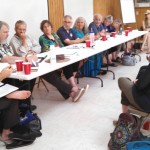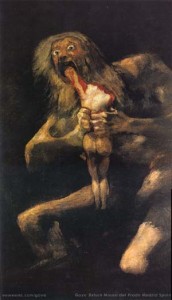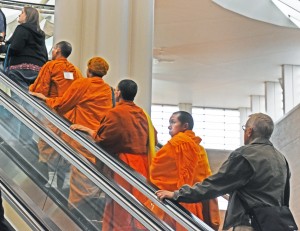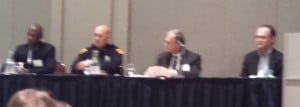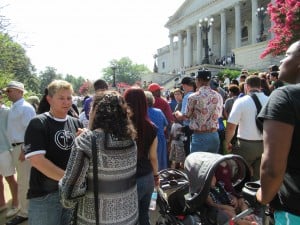I have just returned from my annual vacation in Pennsylvania where my husband and I attend Pennsic War, the world’s largest medieval re-enactment event. This year nearly 11,000 of us who are fascinated by the Middle Ages camped together at Cooper’s Lake enjoying two weeks of friendship and learning in the hills of Western Pennsylvania. During that time we took classes on medieval arts and skills, fought mock battles, danced, sang the hours away, renewed friendships and made new friends. All of this took place in an atmosphere of respect and tolerance.
What, you ask, has this anything to do with interfaith?
What we see at Pennsic is the modern culmination of a 2000-year journey filled with religious warfare, hatred, and genocide based solely on disagreements over whose religion was “true” and which was “false”. In the period of the Roman Empire we saw the persecution of Christians by Pagans, then the reverse of that after Constantine the Great converted to Chrisianity. The great Pagan religions of Europe were undermined and then destroyed either by peaceful conversion or, if they were stubborn, by the sword.
In the later Middle Ages we found the Church itself divided and doing battle against what were perceived as heretic sects throughout Europe. One of these, the Albigensian Crusade against the Cathars in the 1200’s, resulted in some one million dead primarily in France.
From 1095 until 1285 the entire Mediterranean region was locked in a tremendous struggle between Christianity and Islam. Both claimed the Holy Land as their own and countless lives were lost in the battles that raged there and in other countries bordering the Mediterranean, such as Spain, before the Crusades were finally abandoned.
In England the struggle between Catholicism and Protestantism divided the country from the time of Henry VIII until after the reign of William of Orange. Many who were innocent of any crime other than their beliefs about the nature of the Divine were executed, imprisoned, or fled England for the New World.
Even now we watch cases of religious discrimination pop up here in the United States and sometimes result in violence and death. But these incidents are nowhere near as violent or as far ranging as the struggles of earlier centuries. Yet we cannot ignore the hatred and religious bigotry that flies airplanes into the side of buildings, bombs synagogues, guns down children in a playground, or that speaks words of hate against those who hold a different belief than our own.
And here is where Pennsic has a lesson to teach us all.
Pennsic recreates the medieval world in a kinder and gentler light. There are no serfs or slaves. There are no terrible plagues. The warring armies carry swords made not of steel but of rattan and they limit their belligerence to the battlefield. And most of all, there are no battles over religious beliefs. The reasons for the latter are three-fold.
First of all, outright displays of religious symbolism or discussions of religion are generally avoided. This is a nod to the fact that discussions of religion and of politics are hot-button topics that can create discord in a small community such as Pennsic. Here it is understood and generally agreed upon that what one believes in the mundane world is strictly one’s own business.
Secondly, Pennsic is aimed at learning about the Middle Ages…and of course that means learning about the religions of that period and of the wars fought in the name of religion that so devastated the medieval world. It is nearly impossible to educate oneself on the catastrophic results of religious wars and wish to repeat them in our modern world.
And finally, at Pennsic and throughout the rest of the year, those who seek to re-enact the Middle Ages create a persona for themselves. They find a time period that speaks to them and they become a person living in that time and culture. This leads to some interesting juxtapositions. I know a nice Jewish man who dresses and acts as a medieval Saracen. I have met a gentleman from Japan whose persona is that of a Pagan Viking. My friend, a long-standing Wiccan is Catholic in her persona. What this encourages is the study of what the religion of their persona would have been like. And in doing so they become less frightened of the unknown and realize that each religion is seeking to understand the nature of the Divine and how to live rightly with their fellow man.
So the lessons that Pennsic teaches all of us are that knowledge and understanding builds tolerance. And that the beliefs of another are not a threat to our own beliefs.
It has taken us over 2000 years to find our way to this point, and much of the world still struggles to leave its own Dark Ages behind. So I like to hold up the example of Pennsic as what the world could be like if we could but (to paraphrase the Pennsic motto) become “One time enemies, eternal friends.”


